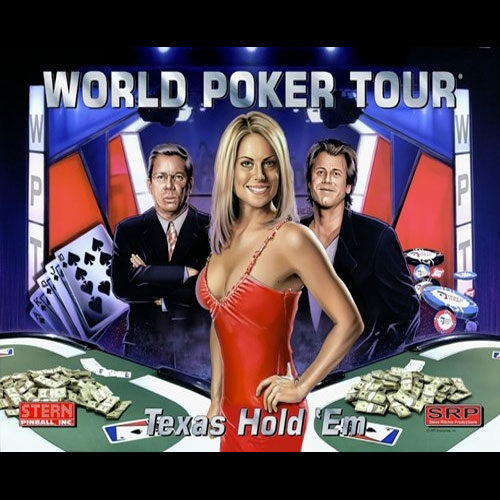-
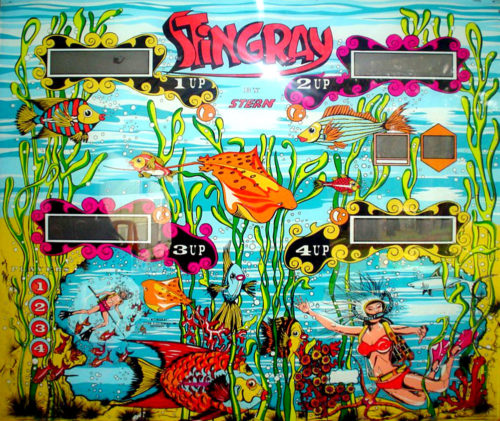 Here’s a 1977 Stern ‘Pinball’. This was Stern’s first solid state machine and marked the beginning of a long and interesting history for the company. Designed by Mike Kubin, it’s a fast game that has some wicked out-lanes and very quick ball times. There are no mini-posts above the out-lane guides which make controlling the ball near the out-lanes very difficult. Stingray, the game made by Stern following ‘Pinball’ also lacked these posts, but games made thereafter had the posts which dramatically improve the player’s ability to control the ball and avoid the out-lane. This game has a basic rule-set. Knock down the 5 drop targets twice in one ball to score the special. The saucer on the right side of the playfield awards a somewhat random award and the spinner shot on the left is a very satisfying shot to hit.
Here’s a 1977 Stern ‘Pinball’. This was Stern’s first solid state machine and marked the beginning of a long and interesting history for the company. Designed by Mike Kubin, it’s a fast game that has some wicked out-lanes and very quick ball times. There are no mini-posts above the out-lane guides which make controlling the ball near the out-lanes very difficult. Stingray, the game made by Stern following ‘Pinball’ also lacked these posts, but games made thereafter had the posts which dramatically improve the player’s ability to control the ball and avoid the out-lane. This game has a basic rule-set. Knock down the 5 drop targets twice in one ball to score the special. The saucer on the right side of the playfield awards a somewhat random award and the spinner shot on the left is a very satisfying shot to hit. -
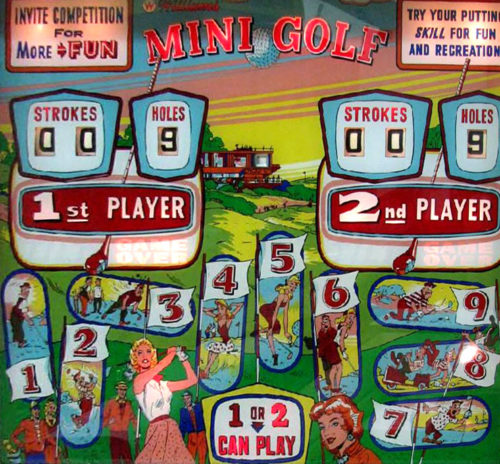 This electromechanical two-player game was designed by Steve Kordek. The game reminds one of an older game, as an animated golfer is on board that you aim to hopefully sink a ball in the appropriate hole. The nine scattered holes are tough to sink, especially the back ones. The lower your score in strokes, the better with this game (no handicap is given). Free games may be awarded set by the operator for low-stroke counts after completing so many holes. A neat and rare game.
This electromechanical two-player game was designed by Steve Kordek. The game reminds one of an older game, as an animated golfer is on board that you aim to hopefully sink a ball in the appropriate hole. The nine scattered holes are tough to sink, especially the back ones. The lower your score in strokes, the better with this game (no handicap is given). Free games may be awarded set by the operator for low-stroke counts after completing so many holes. A neat and rare game. -
 There are 7 Doctors, as one can plainly see from the backglass… quite conveniently, they are numbered 1-7. Each Doctor has the effect of changing the rules of one area of the Playfield, making a list of the rules all the more annoying and probably confusing. First some general information about the Doctors… there are many ways to “spot” doctors throughout the game – one is awarded at the start of any ball, and can be spotted through the Transmat target or Video Mode. At the start of a ball (or when a ball has been locked), you get to choose the “current” doctor – his picture will flash on the backglass. When a doctor- spotting shot is made, the current doctor will become solidly lit (so his attributes are carried over for the rest of the game), and the “current” doctor becomes the previously unlit doctor directly to the left of the previous one. There are 2 ways to spot all seven doctors – either go through them all one-by-one, or shoot the Emperor Daleks jackpot. Either way, all of them will be lit for the rest of the game, and you receive an additional bonus of 2OM, as well as a small animation, which plays even after a tilt! After all 7 doctors are spotted, they can be spotted a second (third, etc) time, and running through all 7 a second time awards another 2OM bonus. Also, each doctor spotted in the game (this count may be more than 7) is worth a 1M bonus at the end of the last ball (so don’t tilt it!), and this bonus (unlike the regular bonus) is multiplied by the Playfield X.
There are 7 Doctors, as one can plainly see from the backglass… quite conveniently, they are numbered 1-7. Each Doctor has the effect of changing the rules of one area of the Playfield, making a list of the rules all the more annoying and probably confusing. First some general information about the Doctors… there are many ways to “spot” doctors throughout the game – one is awarded at the start of any ball, and can be spotted through the Transmat target or Video Mode. At the start of a ball (or when a ball has been locked), you get to choose the “current” doctor – his picture will flash on the backglass. When a doctor- spotting shot is made, the current doctor will become solidly lit (so his attributes are carried over for the rest of the game), and the “current” doctor becomes the previously unlit doctor directly to the left of the previous one. There are 2 ways to spot all seven doctors – either go through them all one-by-one, or shoot the Emperor Daleks jackpot. Either way, all of them will be lit for the rest of the game, and you receive an additional bonus of 2OM, as well as a small animation, which plays even after a tilt! After all 7 doctors are spotted, they can be spotted a second (third, etc) time, and running through all 7 a second time awards another 2OM bonus. Also, each doctor spotted in the game (this count may be more than 7) is worth a 1M bonus at the end of the last ball (so don’t tilt it!), and this bonus (unlike the regular bonus) is multiplied by the Playfield X. -
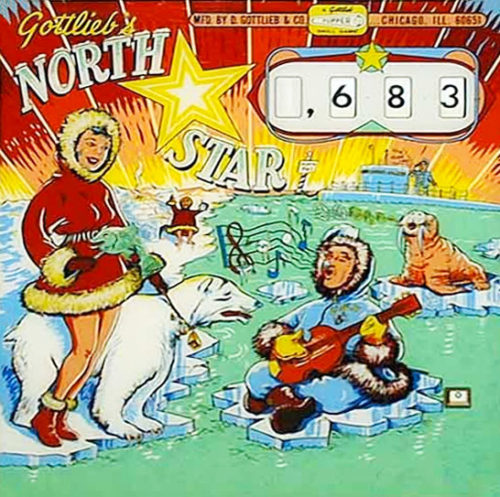
-
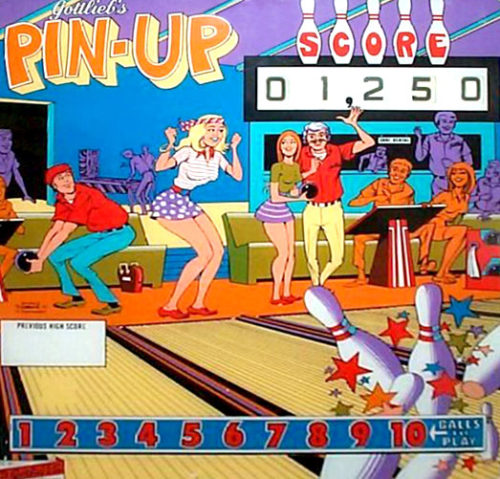 Gottlieb hatched this add-a-ball machine from the skunkworks in April of the year, designed by Ed Krynski and artwork by Gordon Morison. This single-player machine has a bowling theme and only 715 units were produced at that time. The replay version of the game was called King Pin and many more of these machines were produced. The theme of this game is the drop target completion. By carefully aiming the four inherent flippers on board the playfield, one must try to complete the horizontal row of targets. Doing so will reset the targets and the wow feature activates, giving you a shot at the accomplishment of winning extra balls. Score is another way to pop free balls. The ten drop targets are not so easy to complete and the wow feature advances when you roll over the star rollover. This game is challenging, but a beginner can have ample fun with the machine.
Gottlieb hatched this add-a-ball machine from the skunkworks in April of the year, designed by Ed Krynski and artwork by Gordon Morison. This single-player machine has a bowling theme and only 715 units were produced at that time. The replay version of the game was called King Pin and many more of these machines were produced. The theme of this game is the drop target completion. By carefully aiming the four inherent flippers on board the playfield, one must try to complete the horizontal row of targets. Doing so will reset the targets and the wow feature activates, giving you a shot at the accomplishment of winning extra balls. Score is another way to pop free balls. The ten drop targets are not so easy to complete and the wow feature advances when you roll over the star rollover. This game is challenging, but a beginner can have ample fun with the machine. -
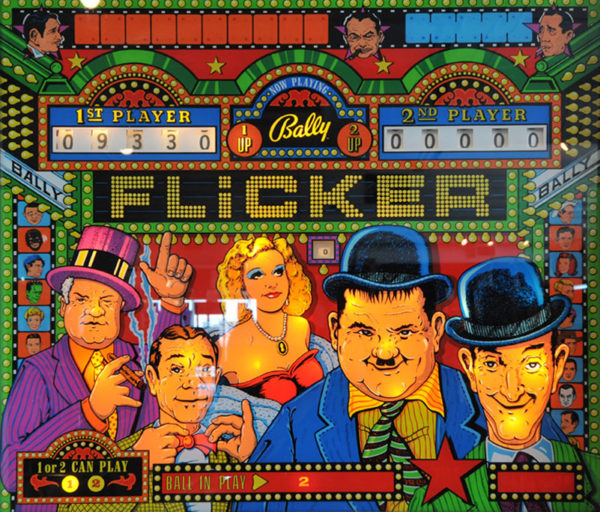 Lorem ipsum dolor sit amet, consectetuer adipiscing elit, sed diam nonummy nibh euismod tincidunt ut laoreet dolore magna aliquam erat volutpat. Ut wisi enim ad minim veniam, quis nostrud exerci tation ullamcorper suscipit lobortis nisl ut aliquip ex ea commodo consequat. Duis autem vel eum iriure dolor in hendrerit in vulputate velit esse molestie consequat, vel illum dolore eu feugiat nulla facilisis at vero eros et accumsan et iusto odio dignissim qui blandit praesent luptatum zzril delenit augue duis dolore te feugait nulla facilisi. Epsum factorial non deposit quid pro quo hic escorol. Olypian quarrels et gorilla congolium sic ad nauseum. Souvlaki ignitus carborundum e pluribus unum. Defacto lingo est igpay atinlay. Marquee selectus non provisio incongruous feline nolo contendre. Gratuitous octopus niacin, sodium glutimate. Quote meon an estimate et non interruptus stadium. Sic tempus fugit esperanto hiccup estrogen. Glorious baklava ex librus hup hey ad infinitum. Non sequitur condominium facile et geranium incognito. Epsum factorial non deposit quid pro quo hic escorol. Marquee selectus non provisio incongruous feline nolo contendre Olypian quarrels et gorilla congolium sic ad nauseum. Souvlaki ignitus carborundum e pluribus unum.
Lorem ipsum dolor sit amet, consectetuer adipiscing elit, sed diam nonummy nibh euismod tincidunt ut laoreet dolore magna aliquam erat volutpat. Ut wisi enim ad minim veniam, quis nostrud exerci tation ullamcorper suscipit lobortis nisl ut aliquip ex ea commodo consequat. Duis autem vel eum iriure dolor in hendrerit in vulputate velit esse molestie consequat, vel illum dolore eu feugiat nulla facilisis at vero eros et accumsan et iusto odio dignissim qui blandit praesent luptatum zzril delenit augue duis dolore te feugait nulla facilisi. Epsum factorial non deposit quid pro quo hic escorol. Olypian quarrels et gorilla congolium sic ad nauseum. Souvlaki ignitus carborundum e pluribus unum. Defacto lingo est igpay atinlay. Marquee selectus non provisio incongruous feline nolo contendre. Gratuitous octopus niacin, sodium glutimate. Quote meon an estimate et non interruptus stadium. Sic tempus fugit esperanto hiccup estrogen. Glorious baklava ex librus hup hey ad infinitum. Non sequitur condominium facile et geranium incognito. Epsum factorial non deposit quid pro quo hic escorol. Marquee selectus non provisio incongruous feline nolo contendre Olypian quarrels et gorilla congolium sic ad nauseum. Souvlaki ignitus carborundum e pluribus unum. -
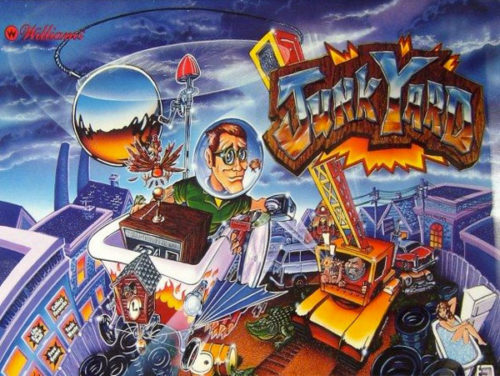 Playfield Layout There are two standard flippers and standard return lanes in the usual positions. The inlanes can be lit to start Crane Hurry-up. The outlanes have quite large openings, and each outlane can be lit separately for a “Ball Recycle”. Above the left out/inlanes there is a popper which returns the ball to the left inlane. Most of the shots that take balls under the playfield return the ball here. On the playfield beside this device is a bank of three standup targets with blue lights in the playfield in front of them, which, when completed, lights the left outlane Recycle. Above this there are two ramps with entrance side-by-side. The far left ramp leads to a toilet, which counts the spins the ball takes inside it before falling under the playfield. The inner ramp carries the ball around the back of the playfield toward a VW bus in the back right corner; a diverter can cause the ball to be temporarily held here or to return directly on a habitrail to the right inlane. This ramp also has an open side which allows slow shots to fall through to an area not otherwise accessible, which dribbles down into the hole in front of the dog. Lights in front of these ramps indicate various available shots. In the center of the top of the playfield is this game’s main feature. The “Crane” is a pinball hanging from a chain. The chain hangs from a bar (which is decorated to look like a crane) that goes into the back wall of the game. This ball can be raised or lowered, to allow the pinball to pass under it, or block its path. The bar itself can move side-to-side and up-and-down slightly, in addition to the wild motion the ball has. Around this, arranged in a semicircle, are 2 banks of 3 standup targets with an opening for another shot (which goes around a corner and under the playfield) between them. Above these there is a row of 5 larger “car” standup targets, with no gap. The crane ball can be hit into these higher targets. Several lights in front of the crane ball indicate shots available on the crane ball (by hitting it into the car standups) or in the opening behind it. There doesn’t seem to be a name for this opening (in some mode, I forget which, the game calls it the alley, but the playfield calls the DOG scoop the alley), so I will call it the center shot. Below the right side crane standups there is an up-scoop which usually drops the ball onto the bus ramp’s habitrail to the right inlane, but a diverter can send it to the dog instead. The dog is a decoration just in front of the bus; when the ball goes to him, it falls into a hole in the playfield in front of him, and if the ball was supposed to be there, a video mode starts. Lights in front of the scoop spell out D-O-G. Just to the left of it there is a small standup target, the Toaster Gun target. Below and slightly to the right of the scoop entrance, there is a sinkhole called the Sewer that can be entered from almost any direction. Lights in front of it indicate a variety of awards which can be available here, including Extra Ball and Adventures. The adventures themselves are indicated by a separate row of lights across the playfield, below the lights for the ramps, crane, and scoop. Below the Sewer there is a bank of 3 blue standups; these light the right outlane Recycle and are similar to their counterparts on the other side of the playfield. The plunger (which is a combination manual and autoplunger) shoots the ball through a spinner and into a sinkhole, which, like other holes on this game, takes the ball to the left inlane feed. Junk In the middle of the lower section of the playfield, in addition to lights for “shoot again” and autofire, there is a blueprint with 10 different pieces of junk marked with lights. Some of the pieces combine to make various contraptions. The junk consists of: Hair dryer, toaster, cuckoo clock, television, weathervane, fishbowl, propeller, fan, bathtub, and bicycle wheels. The game begins with the toaster already awarded. The combinations are: • Hair dryer + toaster = toaster gun • television + weathervane = radar • bicycle wheels + bathtub + fan = jalopy • fishbowl + jalopy = submerger • propeller + jalopy = flying machine There is an extra ball awarded for collecting a certain amount of junk, which is on a percentage; on the game I play it’s awarded on the third junk item. Collecting all the junk lets you enter your initials as junk champion at the end of the game. The current junk champion’s initials are shown on Spike’s collar when each dog video mode begins. Helpful hints At various times during the game, an angel appears on the left of the DMD or a devil appears on the right, and they make some comment. Whenever you collect junk, one or both of them appears and advises you what to collect next. (If your first junk item is anything other than the hair dryer, both appear, the angel advising you to get the hair dryer and the devil advising you to get a part for the radar.) One of these also announces each time an invention is completed, or when an adventure starts.
Playfield Layout There are two standard flippers and standard return lanes in the usual positions. The inlanes can be lit to start Crane Hurry-up. The outlanes have quite large openings, and each outlane can be lit separately for a “Ball Recycle”. Above the left out/inlanes there is a popper which returns the ball to the left inlane. Most of the shots that take balls under the playfield return the ball here. On the playfield beside this device is a bank of three standup targets with blue lights in the playfield in front of them, which, when completed, lights the left outlane Recycle. Above this there are two ramps with entrance side-by-side. The far left ramp leads to a toilet, which counts the spins the ball takes inside it before falling under the playfield. The inner ramp carries the ball around the back of the playfield toward a VW bus in the back right corner; a diverter can cause the ball to be temporarily held here or to return directly on a habitrail to the right inlane. This ramp also has an open side which allows slow shots to fall through to an area not otherwise accessible, which dribbles down into the hole in front of the dog. Lights in front of these ramps indicate various available shots. In the center of the top of the playfield is this game’s main feature. The “Crane” is a pinball hanging from a chain. The chain hangs from a bar (which is decorated to look like a crane) that goes into the back wall of the game. This ball can be raised or lowered, to allow the pinball to pass under it, or block its path. The bar itself can move side-to-side and up-and-down slightly, in addition to the wild motion the ball has. Around this, arranged in a semicircle, are 2 banks of 3 standup targets with an opening for another shot (which goes around a corner and under the playfield) between them. Above these there is a row of 5 larger “car” standup targets, with no gap. The crane ball can be hit into these higher targets. Several lights in front of the crane ball indicate shots available on the crane ball (by hitting it into the car standups) or in the opening behind it. There doesn’t seem to be a name for this opening (in some mode, I forget which, the game calls it the alley, but the playfield calls the DOG scoop the alley), so I will call it the center shot. Below the right side crane standups there is an up-scoop which usually drops the ball onto the bus ramp’s habitrail to the right inlane, but a diverter can send it to the dog instead. The dog is a decoration just in front of the bus; when the ball goes to him, it falls into a hole in the playfield in front of him, and if the ball was supposed to be there, a video mode starts. Lights in front of the scoop spell out D-O-G. Just to the left of it there is a small standup target, the Toaster Gun target. Below and slightly to the right of the scoop entrance, there is a sinkhole called the Sewer that can be entered from almost any direction. Lights in front of it indicate a variety of awards which can be available here, including Extra Ball and Adventures. The adventures themselves are indicated by a separate row of lights across the playfield, below the lights for the ramps, crane, and scoop. Below the Sewer there is a bank of 3 blue standups; these light the right outlane Recycle and are similar to their counterparts on the other side of the playfield. The plunger (which is a combination manual and autoplunger) shoots the ball through a spinner and into a sinkhole, which, like other holes on this game, takes the ball to the left inlane feed. Junk In the middle of the lower section of the playfield, in addition to lights for “shoot again” and autofire, there is a blueprint with 10 different pieces of junk marked with lights. Some of the pieces combine to make various contraptions. The junk consists of: Hair dryer, toaster, cuckoo clock, television, weathervane, fishbowl, propeller, fan, bathtub, and bicycle wheels. The game begins with the toaster already awarded. The combinations are: • Hair dryer + toaster = toaster gun • television + weathervane = radar • bicycle wheels + bathtub + fan = jalopy • fishbowl + jalopy = submerger • propeller + jalopy = flying machine There is an extra ball awarded for collecting a certain amount of junk, which is on a percentage; on the game I play it’s awarded on the third junk item. Collecting all the junk lets you enter your initials as junk champion at the end of the game. The current junk champion’s initials are shown on Spike’s collar when each dog video mode begins. Helpful hints At various times during the game, an angel appears on the left of the DMD or a devil appears on the right, and they make some comment. Whenever you collect junk, one or both of them appears and advises you what to collect next. (If your first junk item is anything other than the hair dryer, both appear, the angel advising you to get the hair dryer and the devil advising you to get a part for the radar.) One of these also announces each time an invention is completed, or when an adventure starts. -

-
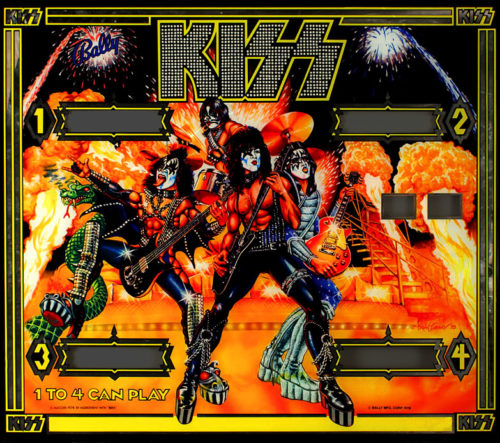 This very collectible game of the ‘70s was another in a series of celebrity-themed tie-in games Bally found license to produce. 17,000 units were made, a sizable number for the day. A prototype speaking version of this game was made ahead of its time but failed to be marketed. The object of the game is to spell out the name KISS. If you complete four times, a super bonus is awarded. Do it again and a colossal bonus is awarded. A third time awards a replay and a ton of points…which can be doubled if the 2x value drop targets are completed. The A, B, C, and D targets also can award extra balls and specials. The left drop targets award the KISS line when completed. All in all, an exciting game with great graphics but no speech. Talking pinballs finally made the scene with the release of Gorgar (in the museum). Replays are also awarded by score or matching. Matching is the process by which the last two numbers of your score match the generated number produced by the game.
This very collectible game of the ‘70s was another in a series of celebrity-themed tie-in games Bally found license to produce. 17,000 units were made, a sizable number for the day. A prototype speaking version of this game was made ahead of its time but failed to be marketed. The object of the game is to spell out the name KISS. If you complete four times, a super bonus is awarded. Do it again and a colossal bonus is awarded. A third time awards a replay and a ton of points…which can be doubled if the 2x value drop targets are completed. The A, B, C, and D targets also can award extra balls and specials. The left drop targets award the KISS line when completed. All in all, an exciting game with great graphics but no speech. Talking pinballs finally made the scene with the release of Gorgar (in the museum). Replays are also awarded by score or matching. Matching is the process by which the last two numbers of your score match the generated number produced by the game. -
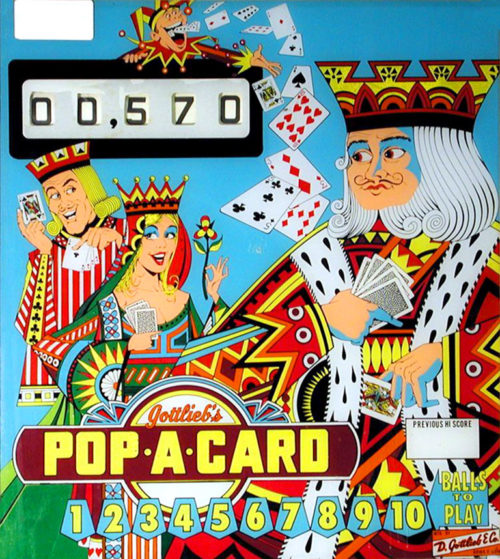 Gottlieb Pop-A-Card was another classic ‘70s playfield designed by Ed Krynski with artwork by Gordon Morison. Only 825 of these units were made. The replay version of the game was called Drop–A-Card which, as usual, was a much higher produced machine. The open playfield of this game gives ample room for scoring the three banks of drop targets. To win free balls with this game, you have to either complete the 2, 3, 4, and 5 targets, or the 6, 7, 8, and 9 targets…or the 10, J, Q, K, and Ace targets. The first two options light the wow feature to award free balls during that ball in play. If you hit the 10 thru Ace targets to completion, four rollovers light up to score extra balls. Of course, score is another way to score more balls.
Gottlieb Pop-A-Card was another classic ‘70s playfield designed by Ed Krynski with artwork by Gordon Morison. Only 825 of these units were made. The replay version of the game was called Drop–A-Card which, as usual, was a much higher produced machine. The open playfield of this game gives ample room for scoring the three banks of drop targets. To win free balls with this game, you have to either complete the 2, 3, 4, and 5 targets, or the 6, 7, 8, and 9 targets…or the 10, J, Q, K, and Ace targets. The first two options light the wow feature to award free balls during that ball in play. If you hit the 10 thru Ace targets to completion, four rollovers light up to score extra balls. Of course, score is another way to score more balls. -
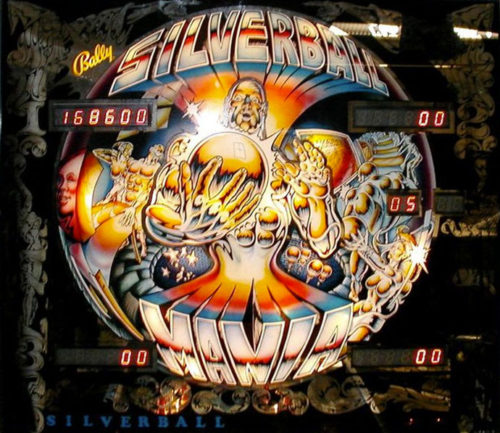 10,350 of these machines made it through the doors of Bally in 1978. Designed by the great Jim Patla and art package by Kevin O’Conner, this early wide body machine is a perfect match for the pinball trade as well as this museum. Even though it was made prior to vocalization in pinball machines, the sounds of the machine draw one in to play its features. All the technology of the 70s is present here with drop targets, loop shots, advancing bonus features and a novel kick back kicker between the flippers which, once achieved, brings the ball back into play instead of draining. Completing the spelling of “Silverball Mania” advances the bonus features. If you complete this feat three times in a game, a built in carrier feature advances on the backglass and awards an operator-adjustable reward, classically three free games. A great playfield flow was designed into the game with two “back to the top” shots enticing players along.
10,350 of these machines made it through the doors of Bally in 1978. Designed by the great Jim Patla and art package by Kevin O’Conner, this early wide body machine is a perfect match for the pinball trade as well as this museum. Even though it was made prior to vocalization in pinball machines, the sounds of the machine draw one in to play its features. All the technology of the 70s is present here with drop targets, loop shots, advancing bonus features and a novel kick back kicker between the flippers which, once achieved, brings the ball back into play instead of draining. Completing the spelling of “Silverball Mania” advances the bonus features. If you complete this feat three times in a game, a built in carrier feature advances on the backglass and awards an operator-adjustable reward, classically three free games. A great playfield flow was designed into the game with two “back to the top” shots enticing players along. -
